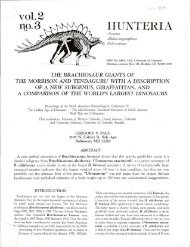THE MANY MYTHS, SOME OLD, SOME NEW, OF ... - Gregory S. Paul
THE MANY MYTHS, SOME OLD, SOME NEW, OF ... - Gregory S. Paul
THE MANY MYTHS, SOME OLD, SOME NEW, OF ... - Gregory S. Paul
Create successful ePaper yourself
Turn your PDF publications into a flip-book with our unique Google optimized e-Paper software.
90 G. S. PAUL<br />
E<br />
z<br />
~<br />
~1.0<br />
Z<br />
S<br />
10<br />
~aC--\<br />
f ..•.•.......... .s-:" b 2.85<br />
01 1.0 10<br />
BODY MASS kg<br />
• •.•fT·<br />
-----<br />
o @t~<br />
(!E) ..:..-e<br />
----<br />
Figure 9 The relationship of wingspan and body mass in birds, including a-albatross, b-bustard,<br />
c----;:ondor, s-swan and t-Argentavis, ultralight aircraft and 12 m class sailplanes (inverted triangles),<br />
and the giant pterosaurs Pteranodon ingens (5.9 m span) and P. sternbergi (8 m) (dotted circles), arid<br />
Quetzalcoatlus sp. (4.7 m) and Q. northropi (11-12 m) (SOlidcircles). Low mass estimates of the giant<br />
pterosaurs that assumed unrealistically low specific gravities or an atrophied musculature are indicated<br />
with small symbols, mass estimates derived from more reasonable parameters are indicated with the large<br />
symbols. Note that the higher mass estimates still leave giant pterosaurs lightly loaded compared to large<br />
birds, and similar to light aircraft.<br />
BIG FLIERS ARE SOARERS<br />
Myth: The largst living and extinct flying birds are low power, energy efficient<br />
soarers. The largest pterosaurs should have followed this pattern (Bramwell and<br />
Whitfield, 1974; Desmond, 1976; Brower, 1983; Padian, 1983; McGowan, 1984;<br />
Pennycuick, 1986; Wellnhofer, 1988; Alexander, 1989).<br />
Reality: The heaviest living fliers, swans and bustards of up to 18 kg, never soar, so<br />
big birds do not establish soaring as the preferred flight mode for large fliers. The<br />
largest pterosaurs, pteranodontids and azhdarchids, have very large pectoral crests<br />
that should have anchored very large flight muscles. Azhdarchids additionally have<br />
thick, high drag inner wings that are poorly suited for soaring, but give great strength<br />
and leverage for powerful flight muscles. These adaptations indicate that powered<br />
flight was an important form of large pterosaur flight, probably the primary one in<br />
azhdarchids (<strong>Paul</strong>, 1990b). This is energetically feasible because the estimated ratio<br />
of sustained metabolic output to standard metabolic rate is.similar in azhdarchids and<br />
swans power flying at 60 km/h (about 25/1).<br />
IT WAS NOT AS WINDY IN <strong>THE</strong> MESOZOIC<br />
Myth: Because the polar-equatorial temperature gradient was not as strong in the<br />
Mesozoic, winds were not as strong. This favored the evolution of slow, lightweight<br />
pterosaurs (Bramwell and Whitfield, 1974; Desmond, 1976; Brower, 1983).<br />
Reality: Climatic modelling by Barron and Washington (1982) suggests that Cret-<br />
100









